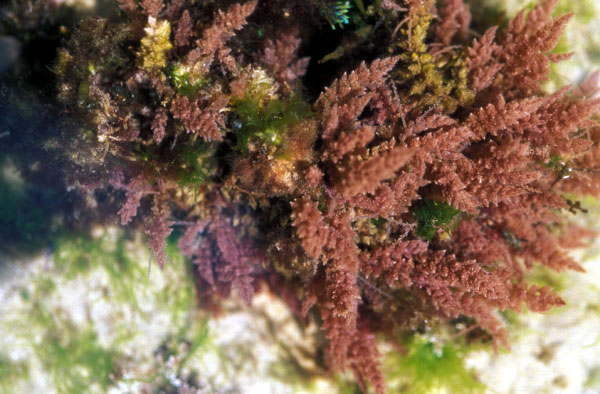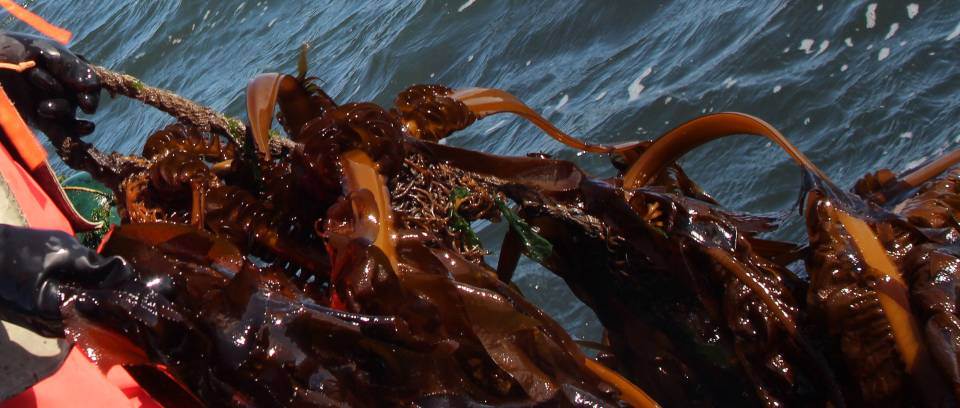Global demand for macroalgal and microalgal foods is growing, and algae are increasingly being consumed for functional benefits beyond the traditional considerations of nutrition and health. There is substantial evidence for the health benefits of algal-derived food products, but there remain considerable challenges in quantifying these benefits, as well as possible adverse effects. First, there is a limited understanding of nutritional composition across algal species, geographical regions, and seasons, all of which can substantially affect their dietary value. The second issue is quantifying which fractions of algal foods are bioavailable to humans, and which factors influence how food constituents are released, ranging from food preparation through genetic differentiation in the gut microbiome. Third is understanding how algal nutritional and functional constituents interact in human metabolism. Superimposed considerations are the effects of harvesting, storage, and food processing techniques that can dramatically influence the potential nutritive value of algal-derived foods. We highlight this rapidly advancing area of algal science with a particular focus on the key research required to assess better the health benefits of an alga or algal product. There are rich opportunities for phycologists in this emerging field, requiring exciting new experimental and collaborative approaches.
Digital library
-
-
Seaplants (a better alternative to the misnomer “Seaweeds”), by all means, are “future plants”; they have been projected as the future viand for ever-increasing human populations, viable and sustainable source for biofuel without disturbing global food scenario, as potential candidates for carbon capture and sequestration that is considered as a practical remedy for global warming, and they have a number of pharmaceutical, industrial and biotechnological applications. However, information on its cultivation methods or life history remain obscure to a majority of marine botanists. While life histories of seaweeds have traditionally been an exotic topic for specialists-language of which is ciphered with scientific jargons incomprehensible to general scientific audience, its agronomy had been a trade secret for coastal communities in East Asian countries, especially Japan, the Philippines and Indonesia. In this up-to-date illustrated review, current scientific understanding on the life-histories of agronomically pertinent seaweeds are presented in a fashion akin to popular science journalism with an overview of major coastal and offshore seaweed mariculture techniques, presented with the aid of clear-tounderstand illustrations. Also discussed in this report are recent advances in the algal natural products; including uses in hydrocolloid and pharmaceutical industries, Integrated Multi Trophic Aquaculture, energy production, environmental impacts of the seafarming and its counter measures, before concluding with an overview of future research avenues.
-
Ecklonia cava is popular in Korea as a marine functional materials. E. cava is generally collected and used on the coast of Jeju Island. However, the continuous use of collected natural E. cava may be limited because difficult to secure throughout the year and may be exposed to environmental pollution. Jeju magma seawater (MSW) was known to be significant advantages such as safety, cleanness, stability, and functional improvement. Attempts have been reported on application of MSW to the culturing of macro- and microalgae and showed improved results. Thus, the objective of the present study was to explore the anti-melanogenesis activity of brown seaweed E. cava (E. cava cultured with MSW [MSWE]) extract cultured in tanks with MSW of Jeju Island to evaluate the possibility of cosmeceutical industrial application. MSWE extract showed the higher polyphenolic and dieckol contents than natural E. cava (NE) extract. Anti-melanogenesis activity of MSWE extract and NE extract are tested and compared using tyrosinase and dihydroxy-phenylalanine (DOPA) oxidation inhibition assay. MSWE extracts evidenced more effective tyrosinase and DOPA oxidation inhibition activity than that of the NE extracts and the commercial whitening agent, arbutin. MSWE extracts also markedly inhibited melanin synthesis and decreased the expression of melanogenesis-related protein in α-melanocytestimulating hormone-stimulated B16F10 melanoma cells without cytotoxicity. These results suggest that MSW cultivation process would be more effective in releasing bioactive compounds with whitening effect from seaweed such as E. cava at an industrial scale.
-
Seaweed is one of the largest producers of biomass in marine environment and is a rich arsenal of active metabolites and functional ingredients with valuable beneficial health effects. Being a staple part of Asian cuisine, investigations on the crude extracts of Phaeophyceae or brown algae revealed marked antitumor activity, eliciting a variety of research to determine the active ingredients involved in this potential. The sulfated polysaccharide of fucoidan and carotenoid of fucoxanthin were found to be the most important active metabolites of brown algae as potential chemotherapeutic or chemopreventive agents. This review strives to provide detailed account of all current knowledge on the anticancer and antitumor activity of fucoidan and fucoxanthin as the two major metabolites isolated from brown algae.
-
The underlying physiology of algal antioxidant compounds is reviewed in the context of seaweed biology and utilization. The application of seaweed antioxidants in foods, food supplements, nutraceuticals and medicine is considered from the perspective of benefits to human health. We advocate that direct consumption of seaweed products for their antioxidant composition alone provides a useful alternative to non-natural substances, while simultaneously providing worthwhile nutritional benefits. Economic utilization of seaweeds for their antioxidant properties remains in its infancy. This review provides examples ranging from laboratory studies through to clinical trials where antioxidants derived from seaweeds may provide major health benefits that warrant subsequent investigative studies and possible utilization.
-
Marine-derived sulfated polysaccharides possess various antiviral activities against a broad range of enveloped and non-enveloped viruses. It has become the potential source of antiviral drugs for pharmaceutical develop- ment. In this review, we will discuss the different types of sulfated polysaccharides and their structural classi- fication. Some of the major sulfated polysaccharides with potent antiviral activity, including carrageenan, agar, ulvan, fucoidan, and alginates, are considered in this review. The mechanism of these sulfated polysaccharides in inhibiting the different stages of the viral infection process inside the host cell is also demonstrated. It involves blocking the initial entry of the virus or inhibiting its transcription and translation by modulating the immune response of the host cell. In addition, we explore the potential of sulfated polysaccharides as antiviral agents in preventing recent Corona Virus Disease-2019 (COVID-19).
-
Edible seaweeds are a good source of antioxidants, dietary fibers, essential amino acids, vitamins, phytochemi- cals, polyunsaturated fatty acids, and minerals. Many studies have evaluated the gelling, thickening and thera- peutic properties of seaweeds when they are used individually. This review gives an overview on the nutritional, textural, sensorial, and health-related properties of food products enriched with seaweeds and sea- weed extracts. The effect of seaweed incorporation on properties of meat, fish, bakery, and other food products were highlighted in depth. Moreover, the positive effects of foods enriched with seaweeds and seaweed extracts on different lifestyle diseases such as obesity, dyslipidemia, hypertension, and diabetes were also discussed. The results of the studies demonstrated that the addition of seaweeds, in powder or extract form, can improve the nutritional and textural properties of food products. Additionally, low-fat products with less calories and less sat- urated fatty acids can be prepared using seaweeds. Moreover, the addition of seaweeds also affected the health properties of food products. The results of these studies demonstrated that the health value, shelf-life and overall quality of foods can be improved through the addition of either seaweeds or seaweed extracts.
-
Seaweeds have a long history of use as food, as flavouring agents, and find use in traditional folk medicine. Seaweed products range from food, feed, and dietary supplements to pharmaceuticals, and from bioenergy intermediates to materials. At present, 98% of the seaweed required by the seaweed industry is provided by five genera and only ten species. The two brown kelp seaweeds Laminaria digitata, a native Irish species, and Macrocystis pyrifera, a native New Zealand species, are not included in these eleven species, although they have been used as dietary supplements and as animal and fish feed. The properties associated with the polysaccharides and proteins from these two species have resulted in increased interest in them, enabling their use as functional foods. Improvements and optimisations in aquaculture methods and bioproduct extractions are essential to realise the commercial potential of these seaweeds. Recent advances in optimising these processes are outlined in this review, as well as potential future applications of L. digitata and, to a greater extent, M. pyrifera which, to date, has been predominately only wild-harvested. These include bio-refinery processing to produce ingredients for nutricosmetics, functional foods, cosmeceuticals, and bioplastics. Areas that currently limit the commercial potential of these two species are highlighted.
-
Background: Dietary habit is one of the important determinants of health. Investigation of the association between diet and blood lipids at the food product level is more advantageous than that at the nutrient level because the results can be applied more directly to improving dietary habits for disease prevention.
Methods: The integrated datasets of the NIPPON DATA and National Nutrition Surveys in Japan conducted in 1980 and 1990 were used for analysis. The association between serum total cholesterol concentration and food group intake was examined by multiple linear regression analysis separately for sex and survey year with data adjusted for age, body mass index and total energy intake.
Results: Intakes of rice, sugar, sweets and snacks, fruit and vegetables other than green and yellow ones were lower and intakes of green and yellow vegetables, mushrooms, seaweed, eggs and milk were higher in the 1990 survey than in the 1980 survey. Intakes of meat, milk and eggs showed a positive association with serum total cholesterol concentration in both sexes while intake of legumes showed a negative association only in men in both the 1980 and 1990 surveys.
Conclusions: Sex- and age-specific food group intakes for 1980 and 1990 were identified, and positive and negative associations between serum total cholesterol concentration and food group intake were revealed in a representative sample of the Japanese population. The results provide some insights into the improvements in dietary habits that can be made for disease prevention in Japan.
-
Major progress has been made in the past decade towards understanding of the biosynthesis of red carotenoid astaxanthin and its roles in stress response while exploiting microalgae-based astaxanthin as a potent antioxidant for human health and as a coloring agent for aquaculture applications. In this review, astaxanthin-producing green microalgae are briefly summarized with Haematococcus pluvialis and Chlorella zofingiensis recognized to be the most popular astaxanthin-producers. Two distinct pathways for astaxanthin synthesis along with associated cellular, physiological, and biochemical changes are elucidated using H. pluvialis and C. zofingiensis as the model systems. Interactions between astaxanthin biosynthesis and photosynthesis, fatty acid biosynthesis and enzymatic defense systems are described in the context of multiple lines of defense mechanisms working in concert against photooxidative stress. Major pros and cons of mass cultivation of H. pluvialis and C. zofingiensis in phototrophic, heterotrophic, and mixotrophic culture modes are analyzed. Recent progress in genetic engineering of plants and microalgae for astaxanthin production is presented. Future advancement in microalgal astaxanthin research will depend largely on genome sequencing of H. pluvialis and C. zofingiensis and genetic toolbox development. Continuous effort along the heterotrophic-phototrophic culture mode could lead to major expansion of the microalgal astaxanthin industry.





